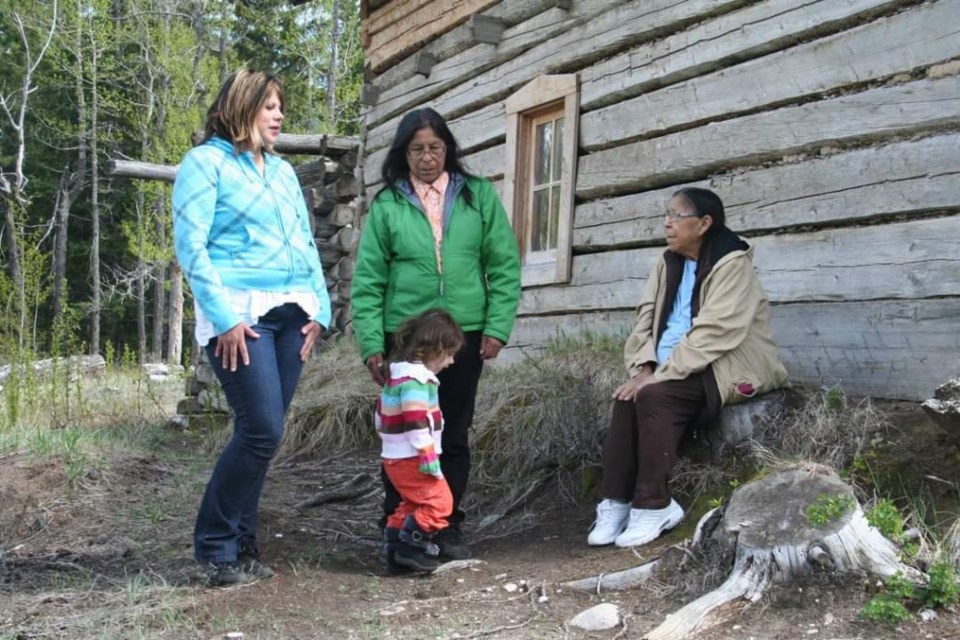
Jason Stockfish | [email protected]
As Canada prepares to celebrate National Indigenous Peoples Day on June 21, descendants of one of the areaÔÇÖs most recognized settlers discussed their familyÔÇÖs history in the region.
Mabel Wanyandie, Russell Wanyandie and Stuart McDonald spoke of the legacy of Ewan Moberly and the Aseniwuche Winewak people on lands now known as Jasper National Park and Grande Cache.
Moberly was the great grandfather of Mabel, Russell and McDonald's late mother, Marie.
The WanyandiesÔÇÖ grandfather, Dolphus Moberly, helped his father, Ewan, to build a homestead that is now a Parks Canada historic site.
Located just outside of Jasper, Ewan MoberlyÔÇÖs homestead is found a little over five kilometers down Celestine Road.
In reality, the settlement is more recent than historic.
In 1907, the federal government of Canada announced that the area would be known as the Jasper Forest Reserve, and Indigenous families who had long lived in the region were being evicted from their homeland as a result.
It was not that people were not permitted to reside within the forest reserve, it was that certain people and families could not, despite having lived on the land for generations.
As European settlers moved in and the railway wound its way to Jasper and beyond, Indigenous people were forced off the land, their knowledge and contributions carelessly discarded.
The Moberlys, and other Indigenous families living in Jasper at the time, had relatives who had long settled in areas now known as Grande Cache and Smoky River.
Around 1910-11, the Moberly family and their neighbours packed up their belongings and livestock and began the long trek to more welcoming lands, leaving behind settlements such as EwanÔÇÖs.
They endured what was at least a month-long journey, according to Mabel, who had knowledge of the trip passed down to her from a friend of her grandfatherÔÇÖs.
The arduous trail was about 180 kilometres through dense forest, muskeg and high mountain passes.
ÔÇťThey would have sent a group of people out to clear the trail,ÔÇŁ McDonald said.
As the trail was cleared, the forced migrants would have brought their belongings behind the clearing crew.
ÔÇťAnd behind their belongings they would have their cattleÔÇŽtheir horses and their farming equipment,ÔÇŁ McDonald added.
When they arrived in the Grande Cache area, the families brought with them letters from the federal government stating they were never to be disturbed again.
However, history repeated itself, and those letters proved to be as worthless as the treaties Indigenous people signed with the Crown.
ÔÇťThe discovery of coal in the Grande Cache area ignited industrial and residential developments that would shape the town and forever change the ways and lives of the Aseniwuche Winewak,ÔÇŁ explained the Aseniwuche Winewak NationÔÇÖs website.
ÔÇťThe local Indigenous community was not consulted or invited to participate in any development decisions, because they had no legally recognized title to the land (and) many traditional sites, homes and gravesites were destroyed, triggering a legacy of loss.ÔÇŁ
In 1974, under the provincial Cooperative Association Act, land settlement agreements were devised, which allocated seven parcels of land for those who first settled in the Grande Cache area.
ÔÇťFollowing the 1974 (agreement), Alberta subsequently filed caveats on the titles to stop the Aseniwuche Winewak from selling or developing the land without government approval,ÔÇŁ AWNÔÇÖs website explained.
ÔÇťThe lands must be held communally and cannot be owned or mortgaged by individuals.ÔÇŁ
No cash compensation for land used as provincial parks, the townsite or the coal mine has ever been offered.
The Aseniwuche Winewak people are of mixed Indigenous descent, predominantly Cree, Iroquois, Sekani, Dene, Ojibwe, Assiniboine and Shuswap people.
ÔÇťWe have a clear, documented history of living and working in our Traditional Territory since the 1700s, although archaeological evidence from several sites and across a range of dates shows that groups of Indigenous people, likely ancestors of the Dene and Sekani, lived and harvested the land in the Grande Cache area continuously for about 10,000 years,ÔÇŁ the AWN stated.
ÔÇťThe Iroquois and Nipissing voyageurs came west with the fur trade; some settled in the Jasper to Dunvegan region (marrying) Sekani women, and their descendants married local Cree, Anishnabe (Ojibwa), Assiniboine (Stoney), Dene (Beaver) and Shuswap people.ÔÇŁ
The descendants of these Indigenous peoples became the patriarchs and matriarchs of some of the areaÔÇÖs local families, including the Desjarlais, Delormes, Findlays, Joachims, Karakunties, McDonalds, Moberlys and Wanyandies.
Many are not recognized as treaty people despite their ancestorsÔÇÖ documented and proven connection to the land for millennia.
To this day, descendants of those who lived upon and harvested the land in Jasper pre-European contactÔÇötrading in goods fundamental to the economy of CanadaÔÇöcontinue to reside on land to which they possess no right of ownership.
As National Indigenous History Month turns to Canada Day, historic sites such as that built by Mabel and RussellÔÇÖs grandfather and great grandfather will become the site of photo opportunities.
They will also become the site of opportunities to accept truths in order to move toward reconciliation.
ÔÇťReconciliationÔÇŽwill always be an ongoing process to acknowledge the rights and wrongs of the past and itÔÇÖs going to be a tough word to promise and fulfill,ÔÇŁ McDonald said.
ÔÇťAnd sometimes it may feel like itÔÇÖs going to be impossible, (but) I think the more people are aware of what reconciliation really means, the quicker we may achieve it.ÔÇŁ
Reconciliation is a process that individuals and communities must work towards with intent and purpose, clearing a path so the next generations can continue the work, McDonald added.
Mabel's belief is that society must focus on the future to be successful and that involves speaking with children about CanadaÔÇÖs history, despite the difficulty of having to tell them about some hard truths in life.



